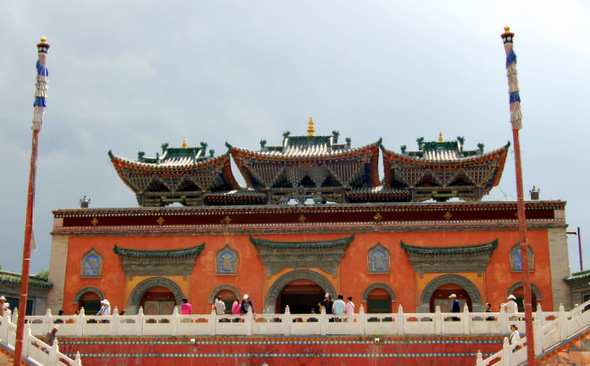China has already expended USD16 million toward the restoration and renovation of Kumbum Monastery, an important historical site of great religious significance where Lama Tsongkhapa was born.
Kumbum Monastery is named after the 100,000 images of the Buddha Sinhanada on the leaves of the holy sandalwood tree. A drop of blood fell from Tsongkhapa’s umbilical cord when it was cut after his birth. From this drop grew a wondrous white sandalwood tree. It has a very broad trunk and 100,000 leaves, which it never sheds. In Tibetan, the number 100,000 merely signifies a very large number, and is not meant literally. On each leaf is an image of the Buddha Sinhanada.
Tsongkhapa’s mother, with the help of the local faithful, built a small temple with a stupa around this tree. It stands to this day. This was the first temple at Kumbum.
Whatever spiritual practices one does at this site are said to bring rebirth in Maitreya’s Pure Land.

Xinhua, August 6, 2014
In the steamy mountainside region of Qinghai province, a key Tibetan temple is undergoing huge renovations as millions are being spent to help the holy site battle the elements.
The Kumbum Monastery, built in the birthplace of Lama Tsongkhapa, founder of the Gelukpa School of Tibetan Buddhism in northwest China, attracts millions of pilgrims and tourists each year.
But the hot and humid mountain climate surrounding Xining, capital of Qinghai province, where the temple rests is threatening the livelihood of the 700-year-old place of worship.
Centuries of erosion have split many of the temple's religious murals. Some of the site's temple halls have suffered groundwork subsidence that have led to deformed pillars and cracked walls.
With the help of experts and funding from the central government, the temple is fighting back against mother nature.
Since the 1990s, the central government has invested more than 100 million yuan (16 million U.S. dollars) towards renovating the famous monastery.
The latest round of renovations, worth 17 million yuan, will see the site's four main temple halls receive a full facelift and began in January of this year.
While 7 million of the most recent renovation fund was provided by the temple itself, the remainder was provided by the government.
Their efforts have gone a long way toward ensuring the temple will be around for years to come, said Losang Goenqog, deputy director of the monastery's management committee.
"Every year, the monastery undergoes certain repair projects on its halls and rooms. It's a huge cost and we can't afford it only with ticket sales and donations," he said.
With more than 10,000 halls and rooms, there is always work to be done, he said. X In addition to funding, experts from the State Administration of Cultural Heritage travel to the monastery to help plan the annual renovations, directing the repair work to make sure the temples are restored as close as possible to the original design.
The Kumbum monastery was built in 1379 in a narrow valley on the outskirts of Xining as a tribute to the famous Buddhist leader, Lama Tsongkhapa. Born in 1357, Tsongkhapa is credited with founding the Gelukpa school of Buddhism, also known as the Yellow Hat sect. The Dalai Lama and Panchen Lama are currently the high lamas of the school.
As one of six key Gelukpa monasteries, Kumbum is also a major tourism attraction in Qinghai known for its "three treasures of art" -- handmade sculptures with white yak butter, wall paintings and silk paintings depicting scenes from the Buddha's teachings.
Last year, it received more than 100 million pilgrims and tourists, said Goenqog.
Booming tourism has also brought increasing challenges to the preservation of the centuries-old heritage site. "We are considering a daily limit on visitor numbers for safety concerns," he said.